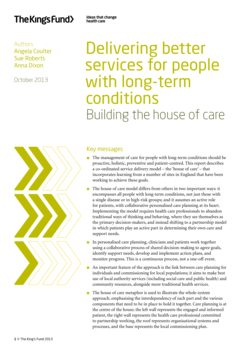Hello! You're looking at a policy document report on Overton
We track government policy, guidelines, think tank research, working papers and more to help our customers see the impact and influence of their work. Are you interested in seeing what information we have to offer? Request a free trial to our platform.
If you fund, produce or manage research or work to influence policy, we'd love to talk. Learn more on our homepage.

Identifiers
Overton ID
kingsfund-8401e3c14860a6723f6af35a4b7811e2
Delivering better services for people with long-term conditions
Sue Roberts, Anna Dixon and Angela Coulter
Our paper describes a co-ordinated service delivery model – the ‘house of care’ – that aims to deliver proactive, holistic and patient-centred care for people with long-term conditions.
Topics in this document
Human activities
Self-care
Medicine
Health sciences
Shared decision-making in medicine
Health
NHS England
Clinical commissioning group
Health care
General practitioner
Primary care
National Health Service
Goal
Community
Community health
Patient
Chronic condition
Social work
Leadership
Department of Health and Social Care
Health literacy
Health economics
Problem solving
Disease
Risk
Public health
Mental health
Hospital
Education
Clinic
Related SDGs
SDG 3: Good Health and Well-being ...
SDG 3: Good Health and Well-being
Target 3.8
Achieve universal health coverage, including financial risk protection, access to quality essential health-care services and access to safe, effective, quality and affordable essential medicines and vaccines for all
Cites research funded by
Citations
Cited by 40
other policy documents
(30 of them are from other policy sources)
